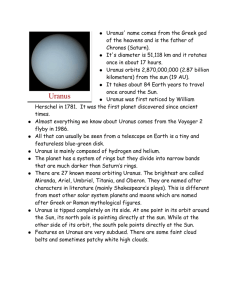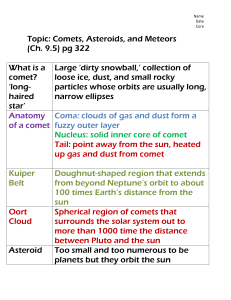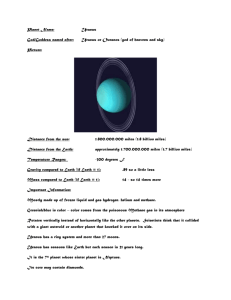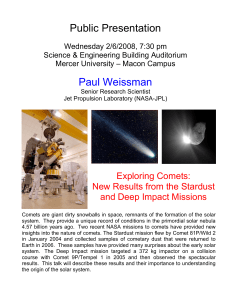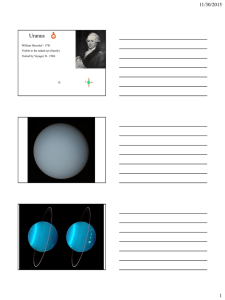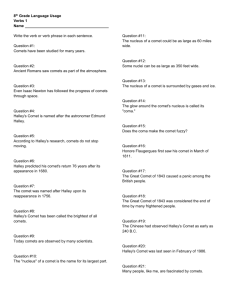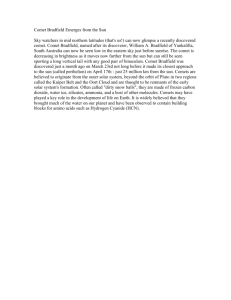LUNCHEON AT THE WHITE HOUSE:
advertisement
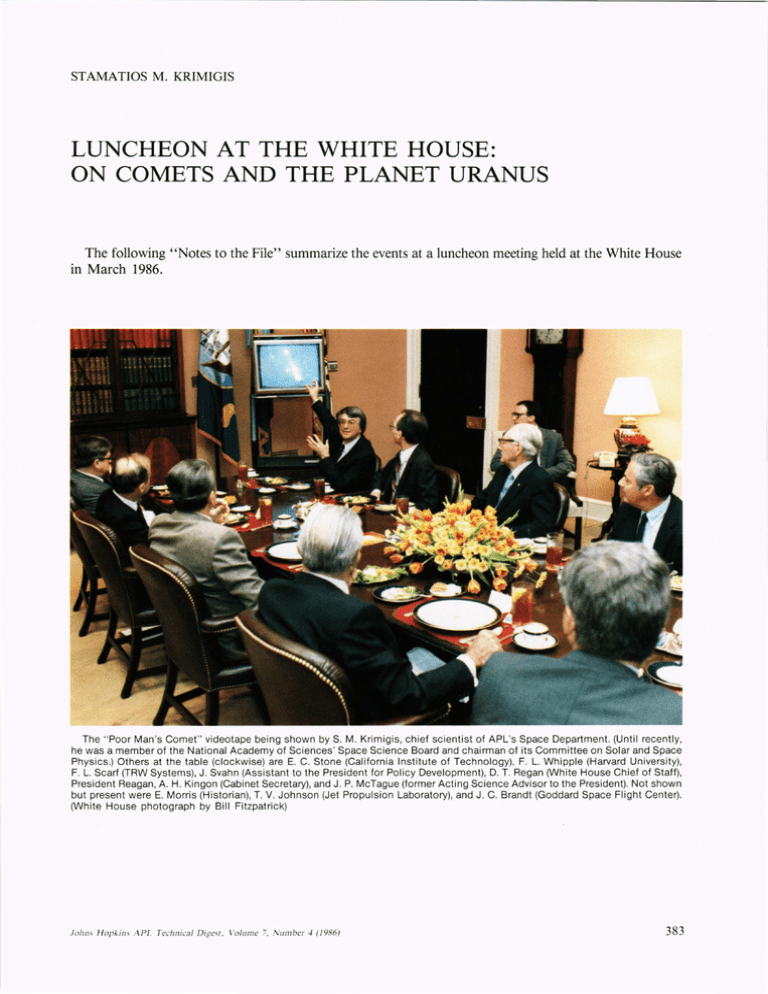
STAMATIOS M. KRIMIGIS
LUNCHEON AT THE WHITE HOUSE:
ON COMETS AND THE PLANET URANUS
The following "Notes to the File" summarize the events at a luncheon meeting held at the White House
in March 1986.
The " Poor Man 's Comet " videotape being shown by S. M. Krimigis, chief scientist of APL's Space Department. (Until recently,
he was a member of the National Academy of Sciences ' Space Science Board and chairman of its Committee on Solar and Space
Physics.) Others at the table (clockwise) are E. C. Stone (California Institute of Technology), F. L. Whipple (Harvard University),
F. L. Scarf (TRW Systems), J. Svahn (Assistant to the President for Policy Development), D. T. Regan (White House Chief of Staff),
President Reagan , A. H. Kingon (Cabinet Secretary), and J. P. McTague (former Acting Science Advisor to the President). Not shown
but present were E. Morris (Historian), T. V. Johnson (Jet Propulsion Laboratory), and J. C. Brandt (Goddard Space Flight Center).
(White House photograph by Bill Fitzpatrick)
John s H opkins APL Technica l Digest , Vo lu me 7, Number 4 (/986)
383
Krimigis -
Luncheon a{ {h e White H ouse: On Comets and Uranus
TH E JO HNS HOPKINS U NIV ER SIT Y
APP LI ED PH Y SI CS LABORAT O RY
LA U REL
M A RYL AN Q
March 26, 1986
To:
File
From:
S. M. Krimigis
Sub j ect:
Lunch with President Ronald Reagan
in the Roosevelt Room of the White House
12:00 Noon to 1:00 P.M., March 26, 1986
Reference:
Invitation telegram, dated March 13, 1986 (attached)
The purpose of this luncheon was to acquaint the President
first-hand about the discoveries, developments and break-throughs in specific
disciplines of Science and Technology from scientific leaders in their
respective fields.
This luncheon was to focus on comets and the planet
Uranus.
The scientists involved were the following:
Fred Whipple - Harvard
University, Ed Stone - California Institute of Technology, Fred Scarf - TRW
Systems, Jack Brandt - Goddard Space Flight Center, Torrence Johnson - Jet
Propulsion Laboratory, and S. M. Krimigis - Johns Hopkins Applied Physics
Laboratory.
Meeting at Science Advisor's Office
We gathered at about 11:00 A.M. in the office of John McTague,
Acting Science Advisor to the President, at the Old Executive Office Building
on the White House Grounds on Pennsylvania Avenue and 17th Street, Room 358.
Dick Johnson, Assistant Director of the Office of
Science and Technology
Policy for Space was present and we had a general discussion on the points
that each was going to cover and the most appropriate sequence to follow in
the discussion.
One of the points that John McTague made was to say a few
words to the President about the future directions in each one of these
research areas.
Each of us had brough t some mementos to leave wi th the
President.
Ed Stone had brought a set of Uranus pictures; also, he and
Torrence Johnson had brought two framed pictures, one of which was a blow-up
of a Miranda image that showed the twelve-mile high cliff.
Jack Brandt
brought a picture, also framed, of Comet Halley observations from Earth
showing a tail disconnection event that took place, I believe, in the course
of twe n t y-four hours from January 10 to 11, 1986, with an overall scale of
about 5,00 0 ,00 0 miles.
He also brought a framed picture of the UV intensity
profile of Comet Halley obtained by the Pioneer Venus spacecraft in orbit
around Venus.
Fred Whipple brought a copy of his recently published book on
Comets, and two or three pictures from the European Giotto spacecraft showing
the active jets as well as the nucleus of Halley's comet. Fred Scarf brought
a tape of sounds from Uranus, including the impacts on the spacecraft as
Voyager crossed the ring plane, chorus from gyrating electrons, and sounds
associated with Miranda.
I broue ht three pictures of the Christmas Comet from
the AMPTE spacecraft and also of the comet release on July 18, 1985; in
addition I had tlte artist's view that we had just put together of Uranus'
magnetosphere.
384
.fohns H opJ.;ins APL Technical Dig~s l. Vo l Lime 7, N umber 4 (1986)
Krimigis -
Luncheon at the White H ouse: On Comets and Uranus
- 2 On to the White HOllse
We left the Old Executive Office Building with John McTague and
walked into the White House about a quarter of twelve and were guided into the
Roosevelt Room, which happens to be across from the Oval Office. The room is
fairly good size and had a long oval table with seating for twelve people, six
on one side and six on the other.
On the wall, on the right-hand side as one
walked in there were paintings of Teddy Roosevelt on his horse as well as his
portrait; on the left-hand side there was a very life-like portrait of
Franklin Delano Roosevelt.
Across from the open door of the Roosevelt Room
one could see the Oval Office which was guarded by what appeared to be a
Marine Guard and we were able to go by and take a look and see all the
furniture inside as well as the shape of the desk.
A TV monitor was in the
room and was intended to show the tape of the first man-made comet which I had
brough t with me, with a person there who was to tell by telephone the
operators of the equipment in an adjacent room the exact time when I needed to
use the tape. Also there was a TV crew that was preparing to tape some of the
session and a photographer who apparently accompanies the President most of
the time.
By the way, John McTague, the Science Advisor, said that the
President is photographed roughly about 200 times a day.
As we stood waiting for the President to come in, we were asked
to stand on one side of the table so that the President would come in and meet
each one of us while the photographer was taking pictures.
A few minutes
after twelve, the President walked in followed by Don Regan, his Chief of
Staff, and others whose names I'll mention, and he came around and met each
one of us and asked our names and the photographer was taking pictures as he
came along and shook hands.
I was seated at the end of one side of the table,
across from John McTague, the Science Advisor, and the Secretary to the
Cabinet, Al Kingon who was next to the President.
On the other side of the
President was Don Regan, and a gentleman by the name of Jack Svahn, who is
Assistant to the President for Policy Development.
At the very end of the
table was seated the President's biographer, Mr. Edmund Morris, who is
apparently accompanying the President to all the meetings he has with
Government officials and the public. Next to me was Ed Stone and next to him,
Fred Whipple, right across from the President.
The Luncheon
After we all sat down, Al Kingon, the Secretary to the Cabinet,
stated that the purpose of this luncheon was to acquaint the President with
recent developments in Science and Technology and that they have had previous
sessions with astrophysicists, scientists working in genetics, and scientists
working on robotics.
After this introduction Fred Whipple presented the
President with his book and began to tell him about comets and how strange
such objects are and proceeded to show him a couple of the pictures of Halley
that were obtained by the European Giotto spacecraft just two weeks ago.
He
tried very hard to point out the jets and talk about the nucleus and the
President was looking at the pictures very intently and he seemed to be
curious about where the nucleus of the comet was; Ed Stone came to the rescue
and pointed out that the dark part is the one that was thought to be the
nucleus and at that point Fred Whipple pulled out a sketch which showed the
Johns Hopkins A PL Technical Digest, Volum e 7, Number 4 (/ 986)
385
Krimigis -
Luncheon at the Wh ite House: On Comets and Uranus
- 3 nucleus to be an irregularly shaped object which was somewhat oval, and Fred
Scarf joked as to whether this was a peanut or a potato and there was general
laughter around the table.
I forgot to mention that when Fred Whipple was talking, Don
Regan wanted to know if the gases from these cometary objects had any
influence on the environment of the Earth and the Earth's atmosphere; Fred
Whipple and Fred Scarf noted that they probably didn't have any impact even
though in 1910, during the last Halley perihelion, the Earth did go through
the tail of the comet and that a lot of quacks were selling medicines which
were supposed to protect people from gases from Halley.
At that point the
President remarked that "you don't suppose that those who were not born in
1910 but rather in 1911, the gases might have had some ill effects on them"
jokingly, and Fred said "Well they might have had some beneficial effects, Mr.
President."
Mr. Regan then asked how many times have there been close
encounters of comets or other objects with Earth in recent times.
Fred
Whipple responded that there had been several , and referred to the impact in
Siberia in 1908, the passage of several asteroids, and the most recent close
flyby of an asteroid over Yellowstone in 1976. The President remarked that if
there were an impending collision with an asteroid, all countries would forget
their differences and unite their efforts in trying to figure out what to
do. This, he said, would show that all humans are like brothers. Fred Scarf
responded that in science we are already working together, like brothers.
We then began to discuss the age of comets and of the universe,
and the President said that he wanted to tell us a story about the professor
and the students:
"Once there was a professor who was explaining information
about the solar system to the students and about the fact that in
a billion years or so the sun would run out of fuel and everything
would grow cold and the Earth would freeze.
This was quite
impressive to the students, and after some respectful silence, one
of the students raised his hand timidly and said 'Professor, tell
me how long did you say that would be' and the Professor said 'Oh
about a billion years' and the student said "Whee, I thought you
had said a mi Ilion years!"
We all laughed at the joke and he proceeded to tell us how he would go out at
night as a kid in the midwest, look at the stars, and wonder whether there was
anyone living out there. He then asked "you gentlemen have investigated a lot
of things in space; have you found any evidence that there may be other people
out there? " We responded that we had not found such evidence, whereupon the
discussion then returned to Comet Halley.
Fred Scarf then pointed
time that a spacecraft had approached
the International Cometary Explorer
Zinner in September of 1985 and, even
386
out that in fact this was not the first
a comet; it was a U.S. spacecraft called
(ICE) that approached comet Giacobinithough it did not have a camera, it
Johns Hopkins APL Technical Digest , Vo lume 7, N umber 4 (/986)
Krimigis -
Luncheon at the White H ouse: On Comets and Uranus
- 4 obtained a great deal of data that was most illuminating. Fred proceeded to
show a picture of the path of the spacecraft through the tail of GiacobiniZinner and pointed out that i t took ICE only about an hour to traverse the
comet's visible tail, but that in fact Giacobini-Zinner activity extended to
at least 100 hours on either side of the nucleus, showing that the influence
of the cometary plasma extended to a great distance from the comet, as far as
about 5 million miles.
Jack Brandt then stepped in and mentioned that the
comet encounters had excited a lot of activity throughout the world including
some participation by U. S. scientists in a program called the International
Halley Watch and showed the President a framed picture with the ground-based
photograph of Halley on January 10; then a piece of the tail of Halley being
torn away by January 11 and pointed out the enormous scale of this activity
namely that it was at least 5 million miles long. Fred Scarf pointed out that
in fact we had just begun to see activity from Come~ Halley from the
International Cometary Explorer, even though that spacecraft was about 20
million miles away from Halley at the present time.
At that time I said that I would like to change the subject
slightly and tell the President about the "Poor Man's Comet" namely one that
was man-made at very high altitude from Earth, and it was a cooperative program between the U.S., the Federal Republic of Germany, and the United
Kingdom. I asked then that the tape be run on the monitor and it came on the
screen right on schedule.
I showed the President the orbits of the U. S. ,
German and British satellites and pointed out where the artificial comet explosion took place, and then that we took these pictures with a high-altitude
camera on an airplane that was flying above the cloud cover; I noted how we
actually could see the tail of the comet forming from the barium cloud that
was initially released, that the experiment had been quite successful, and
that we had saved enough gas to repeat it on the 18th of July 1985 which was
shown on the second part of the tape; that we had learned a great number of
things, including the fact that not a single tail is formed but rather more
than one tail in both cases and that the blobs of this material were being
torn off the main comma and blown downstream to form the tail which in the
case of the July 18 comet was about as long as ten thousand miles.
I also
pointed out that the beauty of this experiment was that it allowed the spacecraft to be right within this cloud and make unique measurements which are not
possible to make with a natural comet, as we had heard earlier; and that it
had provided data which are absolutely essential in interpreting the observations of the European and Soviet spacecraft which made observations of comet
Halley from a substantial distance.
The President seemed to be very interested in what he was seeing. Don Regan asked how much barium did we actually
release to make the artificial comet and I said that it was about a couple of
kilograms.
At this point Ed Stone discussed the planet Uranus and its
atmosphere; the President wanted to know whether it was pronounced Uranus or
Uranus.
He said that when he was watching coverage on network t-;levision
during the encounter by Voyager he couldn't make out which was the correct
pronunciation and we all said that Uranus is the correct pronunciation and
that's what this shall be from now on: Ed Stone pointed out how one side of
the planet is always pointing at the sun, at least around this time of the
John s Hopk i ns APL Technica l Digest. Vo l ume 7, Number 4 (/986)
387
Krimigis -
Luncheon at the White House: On Comets and Uranus
- 5 -
solar system. He went on to explain the blue appearance of Uranus by pointing
out that the red part of sunlight was actually absorbed by the atmosphere and
the blue part was reflected because of the presence of methane in the
atmosphere of Uranus, but that most of the atmosphere consisted principally of
hydrogen gas. Ed then showed the President pictures of the rings, noted that
they are very different than the ones that Voyager observed at Saturn and that
in fact the differences in the two ring systems are not very clearly
understood.
At the end of Ed Stone's presentation, Torrence Johnson spoke
about the moons, pointed out that he had been a moon-person all these years,
and showed a mosaic of Miranda which, as we all know, looks as if it has very
different terrains from various parts of the solar system put together.
Torrence pointed out that we did not have a theory of how this could be
explained but that Dr. McTague said before lunch that this was 'o bviously a
moon that had been put together by a committee. Everybody had a good laugh at
that.
Torrence pointed out that the dark and shiny places show that Miranda
as well as some of the other satellites are made partly of rock and partly of
ice, that some of it was water ice and some probably was methane ice.
He
showed one particular cliff that is very prominent in one of the Voyager
pictures and pointed that this was a cliff 12 miles high in an object that was
300 miles across, indicating that Miranda may well have been broken up
sometime in its history by tectonic activity as well as flows, and it may have
been assembled together from the various pieces. The President said that when
he was growing up he remembers that when people talked about the Earth's moon
that as you looked at it, it had a lot of what seemed like ice and snow on it
and he wondered whether there is any such thing on the moon.
We responded
that no, there was no ice on our moon although it is conceivable, but not
likely, that in the lunar poles in regions which are permanently shielded from
the sun, there could be some ice that may still be present, but we won't know
that unless we go around the moon in a polar orbit.
Af ter that point we had a general discussion, the theme being
that of how important exploration of the solar system was, not only because it
is state-of-the-art technology that always pushes the frontier but also
because it gives people a sense of participation. Ed Stone pointed out that
when Galileo first discovered the moons of Jupiter, nobody could actually see
them unless they went to Galileo's telescope and looked through it.
These
days with the communications systems that are in existence, when we send a
spacecraft such as Voyager to a planet everybody can participate because when
the pictures come back the general public sees them at the same time as the
scientists do. This is a way for the public to share in the discovery and it
is particularly important for young people and students who are thus attracted
to scientific careers.
He also pointed out how much we learn from studying
other planets because of the fact that for example, the weather patterns on
Uranus, where the pole is always facing the sun, is very different from that
at Jupiter, Saturn, and Earth where the planets are rotating with their axis
perpendicular to the ecliptic. It was said that by studying the other planets
we can actually learn a lot more about the state of our own planet and gain
understanding on how s ystems operate on Earth. Then we got into a discussion
on how tilted the magnetic field axis was with respect to the rotation axis
and Ed pointed out that in the case of Uranus the magnetic field is tilted at
388
Johns H opkins APL Technica l Digesl , Vo lum e 7, Number 4 (1986)
Krimi gis -
Luncheon at the White House: On Comets and Uranus
- 6 some 60° which is very different than all the other planets. I then chipped
in to make the point better that if you had a compass on Uranus and wanted to
get· to the North Pole, you would actually end up in San Francisco and the
President got a big kick out of that (actually it's more like Los Angeles).
Ed Stone then pointed out how long the Voyager program had been
in the planning stage and that when we first started working on the program we
were all relatively young; it was well over fifteen years ago and here we are
visiting another planet and hopefully will visit Neptune in 1989.
At that
time I said, "Well, Mr. President I have to tell you a story I heard from Tom
Paine, the Chairman of your National Commission on Space, just the other
night.
As you know these planets only line up everyone hundred and seventy
five years and that is what made this project possible; we used the gravitational pull from one planet to go to the next, and then that to go to the next
one, and so on" and I said "Dr. Paine pointed out that when he came to get
approval for this project from President Nixon he pointed out to him that this
alignment of the planets had last occurred when Thomas Jefferson was
President, and that Jefferson blew it!" At that point everybody broke up and
laughed heartily.
By this time it was one 0' clock and the President
couldn't leave without telling us this other story:
said he
"the story has to do with the time when the children of Israel
were leaving Egypt and they were being chased by the armies of the
Pharoah and were in fairly desperate shape; at which time Moses
decided to go and talk to God about what should be done next. God
said "Well Moses, I have some good news for you and I also have
some bad news" and Moses said "well Lord, tell me the good news
first" and God responded that "the good news is that I have
arranged to have a column of smoke during the day and a pillar of
fire during the night to guide you in the right direction; not
only that, I have arranged that when you all get to the Red Sea, I
will part the waters so you can all walk across the Red Sea and
furthermore, once you get on the other side, and the Egyptians get
into the Red Sea in pursuit, I am going to let the waters come
back together."
Moses then said:
"Well Lord, that sounds
absolutely wonderful, but tell me what is the bad news?" so God
said, "the bad news is that you are going to have to file an
Envi ronmental Impact Statement!"
So we all had a good laugh and then the President thanked us for
being there and said how wonderful it was to have the opportunity to live in
an age when all these technical advancements were possible and how wonderful
the space exploration program was and that he hoped we would have more and
more excitement as time went on.
The President actually did not end the
meeting himself, it was Don Regan who said "Mr. President, I have to remind
you that we are behind schedule and you have another appointment." Up to that
time Mr. Reagan was having a good time with all of uS and asking questions and
so on. As he was preparing to leave, he looked at the pictures we had brought
him which he had carefully stacked at his side. He then said how nice of us
it was to have shown him these pictures and "did we need them back?" We all
Johns H opk ins APL Technical Diges f, Volume 7, Number 4 (/986)
389
Krimi gis -
Luncheon at the White House: On Comets and Uranus
- 7 said we had brought these for him, whereupon he thanked us profusely, tucked
the pictures under his arm and left the room
Back to the Science Advisors' Office
We then left the White House and walked back to the Old
Executive Office Building.
John McTague was very pleased, he thought the
whole thing went exceedingly well and that we were "a bunch of professional
actors" for having put all of this together; Fred Whipple allowed as to how we
have been giving talks about this sort of thing and by golly we had better be
good at it.
McTague, nevertheless, thought that it went especially well and
it couldn't have gone this well if it had been scripted. I pointed out to him
that it could not possibly have gone this well had it been scripted. We went
back to the Science Advisor's Office, picked up our things and left.
That was the end of a memorable day at the White House.
weather was absolutely superb outside, it was in the 70 's, spring had come
a lot of people were allover the streets around the White House, down at
Lincoln Memorial, the Washington Monument grounds, and the Ellipse and it
a rather festive atmosphere throughout the city.
The
and
the
was
SMK: pj
P. S. My secretary reminded me that I did not tell what we had
for lunch.
There was soup (a clear liquid, some sort of consomm~), salad,
roll & butter, with ice tea.
The main course was roast beef (very tender)
with some vegetables;
the dessert was a piece of chocolate cake.
Surprisingly, the President did not have the main course, but ate a sizable
piece of chocolate cake, while the rest of us were working on the roast
beef.
Afterwards John McTague explained that the President skips the main
course in trying to keep his weight down.
The fresh floral centerpiece on the table consisted of orange
tulips and yellow daisies.
The seating arrangement during the luncheon is
shown below.
390
Krimigis
Stone
Whipple
Scarf
Brandt
Johnson
McTague
Kingon
Reagan
Regan
Svahn
Morris
.lo hns H opkin s APL Technical Dig.esi , Vo lum e 7, N um ber
~
(/986)
Krimigis -
MAILGRAM SERVICE CENTER
MIDDLETOWN, VA. 22645
12AM
Luncheon at the White House: On Comets and Uranus
~ ~. ~
al-Igram :!!I
i5 ~
,,,,HS POST,q®
West!£rnM
Union
®
• * '* '* '* ••
1-0051471071 03/12/86 TWX WHITEHOUSE WSH RDVB
065 GOVT MGM WHITE HOUSE DC MAR 12
•
ll. Krfnlf&is
MAR 1 3 1986
KRIMIGIS, STAMATIOS (TOM) M.
CHIEF SCIENTIST, JOHNS HOPKINS UNIVERSITY
APPLIED PHYSICS LABORATORY
JOHNS HOPKINS ROAD
BUILDING 2, ROOM 155
LAUREL, MD 20707
ON BEHALF OF PRESIDENT REAGAN, I WISH TO EXTEND TO YOU AN
INVITATION TO A SMALL LUNCHEON MEETING WITH EMINENT ASTRONOMERS
AND PHYSICISTS ON WEDNESDAY, MARCH 26, 1986 AT 12:00 NOON IN THE
ROOSEVELT ROOM AT THE WHITE HOUSE.
THIS WILL BE THE FOURTH IN A SERIES OF LUNCHEONS WHERE THE
PRESIDENT HEARS FIRSTHAND FROM LEADERS IN SPECIFIC DISCIPLINES IN
SCIENCE AND TECHNOLOGY ABOUT THE DISCOVERIES, DEVELOPMENTS, AND
BREAKTHROUGHS IN THEIR RESPECTIVE FIELDS. THIS LUNC~EON WILL
FOCUS ON COMETS AND THE PLANET URANUS.
YOU SHOULD PLAN TO ARRIVE BY 11:00 A.M. AT THE OFFICE OF SCIENCE
AND TECHNOLOGY IN ROOM 358 OF THE OLD EXECUTIVE OFFICE BU9LDING
AT 17TH AND PENNSYLVANIA AVENUE. PLEASE R.S.V.P. AT 202/456-2800
AND PROVIDE YOUR SOCIAL SECURITY NUMBER AND DATE OF BIRTH.
ALFRED H. KINGON
CABINET SECRETARY
1213 EST
MGMCOMP MGM
TO REPLY BY MAILGRAM MESSAGE, SEE REVERSE SIDE FOR WESTERN UNION'S T
Johns H opkins A PL Technical Digesr, Volum e 7, N umber 4 (1986)
r
I'IEE PHONE NUMBERS
391
Krimigis -
Luncheo n at the White House: On Comets and Uranus
Early March 1986 marked the beginning of a series of encounters with Comet Halley by an international armada of spacecraft and the start of what has been called by J. C. Brandt of
NASA's Goddard Space Flight Center " ...the greatest week
cometary science ever had or is likely to have for quite some
time. " Included in the armada were the European Space Agency's Giotto spacecraft, Russia's Vega I and II probes, and
Japan 's Suissei and Sakigake spacecraft. Most ambitious was
Giotto 's closest approach to within a few hundred kilometers
of Halley's highly active nucleus. Giotto's most notable achievement was its survival and its successfully resolved imaging of
the nucleus in a very hostile dust environment.
This image shows Halley's nucleus as a dark peanut-shaped
object about 14 kilometers long from which bright dust jets are
emanating. Giotto's cameras, which were developed in an international cooperative program led by the Max Planck Institute for Aeronomy, use a Texas Instruments charge-coupled
device sensor.
In a collaborative project among the United States, the Federal Republic of Germany, and the United Kingdom , the AMPTE
(Active Magnetosphere Particle Tracer Explorers) program started with the launch of three satellites on top of a Delta rocket
in August 1984. APL is the Principal Investigator institution for
the U.S. part of the AMPTE program . One of the mission 's objectives was to simulate the interaction of cometary-type gas
with the solar wind by releasing barium atoms at high altitudes,
outside the influence of the earth 's magnetic field. The first opportunity for such a release was in the early morning of December 25, 1984, over the western United States, with the press
dubbing the release the " Christmas Comet. " Because of poor
weather, the experiment took place on December 27, 1984. Pictures were obtained from a high-altitude aircraft with Max Planck
Institute for Extraterrestrial Physics cameras, operated by A.
Valenzuela. A second release was made on July 18, 1985. A
videotape of both releases, prepared with the help of R. Grauel
and his staff at APL, was shown to President Reagan and his
staff during the luncheon.
These pictures of Uranus-one in true color (left) and the other in false color-were compiled from images retu rn ed January 17, 1986, by the narrow-angle camera of Voyager 2. The
spacecraft was 5.7 million miles from the planet, seven days
from closest approach. The picture at left has been processed
to show Uranus as human eyes would see it from the vantage
point of the spacecraft. The darker shadings at the upper right
of the disk correspond to the day-night boundary on the planet. Beyond that boundary lies the hidden northern hemisphere
of Uranus, which currently remains in total darkness as the planet rotates. The blue-green color results from the absorption of
red light by methane gas in Uranus' deep, cold , and remarkably clear atmosphere. The picture at right uses false color and
extreme contrast enhancement to bring out subtle details in
the polar region of Uranus.
392
Joh ns H opki ns APL Technica l Diges[ , Vo lu me 7, N umber 4 (1986)
Krimigis -
Luncheon at the White House: On Comets and Uranus
This dramatic Voyager 2 picture reveals a continuous distribution of small particles throughout the Uranus ring system.
Voyager took the image while in the shadow of Uranus, at a
distance of 147,000 miles and a resolution of about 20 miles.
This unique geometry allows us to see lanes of fine dust particles not visible from other viewing angles. All the previously
known rings are visible here; however, some of the brightest
features in the image are bright dust lanes not previously seen.
The combination of this unique geometry and a long, 96-second
exposure allowed this spectacular observation.
This computer-assembled mosaic of Miranda includes many
of the high-resolution frames obtained by Voyager 2 during its
close flyby of the Uranian moon . Miranda, roughly 300 miles
in diameter, exhibits varied geologic provinces, seen in this mosaic of clear-filter, narrow-angle images from January 24, 1986.
These are among the highest resolution pictures that Voyager
has obtained of any of the new "worlds " it has encountered
during its mission . On Miranda, ridges and valleys of one province are cut off against the boundary of the next province. Probable compressional folded ridges are seen in curvilinear
patterns, as are many extensional faults. Some of these show
very large scarps, or cliffs , up to 12 miles in height-much
higher than the walls of the Grand Canyon on Earth .
This high-resolution image of Miranda was acquired by Voyager 2 on January 24, 1986, at a distance of 22,500 miles. In this
clear-filter, narrow-angle image, Miranda displays a dramatically varied surface. Well shown at this resolution of 2000 feet are
numerous ridges and valleys, a topography that was probably
produced by compressional tectonics. Cutting across the ridges
and valleys are many faults. The largest fault scarp, or cliff, is
seen below and to the right of center; it shows grooves probably made by the contact of the fault blocks as they rubbed
against each other.
J ohns H opkins A PL T echnica l Digl'SI. \ ' o lul71 e 7. N Ul1l bc:r -+ (/ 986)
393
